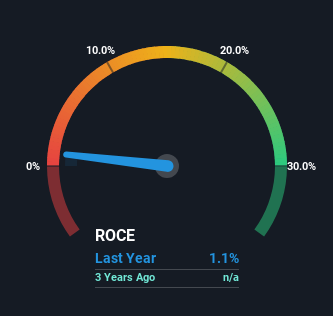Carmel (TLV:CRML) Has Some Difficulty Using Its Capital Effectively
When it comes to investing, there are some useful financial metrics that can warn us when a business is potentially in trouble. More often than not, we'll see a declining return on capital employed (ROCE) and a declining amount of capital employed. This indicates the company is producing less profit from its investments and its total assets are decreasing. So after glancing at the trends within Carmel (TLV:CRML), we weren't too hopeful.
What Is Return On Capital Employed (ROCE)?
For those that aren't sure what ROCE is, it measures the amount of pre-tax profits a company can generate from the capital employed in its business. To calculate this metric for Carmel, this is the formula:
Return on Capital Employed = Earnings Before Interest and Tax (EBIT) ÷ (Total Assets - Current Liabilities)
0.011 = ₪5.5m ÷ (₪774m - ₪269m) (Based on the trailing twelve months to June 2023).
Thus, Carmel has an ROCE of 1.1%. Ultimately, that's a low return and it under-performs the Beverage industry average of 12%.
See our latest analysis for Carmel

Historical performance is a great place to start when researching a stock so above you can see the gauge for Carmel's ROCE against it's prior returns. If you're interested in investigating Carmel's past further, check out this free graph of past earnings, revenue and cash flow.
What Can We Tell From Carmel's ROCE Trend?
There is reason to be cautious about Carmel, given the returns are trending downwards. About two years ago, returns on capital were 2.6%, however they're now substantially lower than that as we saw above. And on the capital employed front, the business is utilizing roughly the same amount of capital as it was back then. Companies that exhibit these attributes tend to not be shrinking, but they can be mature and facing pressure on their margins from competition. So because these trends aren't typically conducive to creating a multi-bagger, we wouldn't hold our breath on Carmel becoming one if things continue as they have.
What We Can Learn From Carmel's ROCE
In summary, it's unfortunate that Carmel is generating lower returns from the same amount of capital. And, the stock has remained flat over the last year, so investors don't seem too impressed either. That being the case, unless the underlying trends revert to a more positive trajectory, we'd consider looking elsewhere.
If you'd like to know about the risks facing Carmel, we've discovered 1 warning sign that you should be aware of.
While Carmel may not currently earn the highest returns, we've compiled a list of companies that currently earn more than 25% return on equity. Check out this free list here.
New: AI Stock Screener & Alerts
Our new AI Stock Screener scans the market every day to uncover opportunities.
• Dividend Powerhouses (3%+ Yield)
• Undervalued Small Caps with Insider Buying
• High growth Tech and AI Companies
Or build your own from over 50 metrics.
Have feedback on this article? Concerned about the content? Get in touch with us directly. Alternatively, email editorial-team (at) simplywallst.com.
This article by Simply Wall St is general in nature. We provide commentary based on historical data and analyst forecasts only using an unbiased methodology and our articles are not intended to be financial advice. It does not constitute a recommendation to buy or sell any stock, and does not take account of your objectives, or your financial situation. We aim to bring you long-term focused analysis driven by fundamental data. Note that our analysis may not factor in the latest price-sensitive company announcements or qualitative material. Simply Wall St has no position in any stocks mentioned.
About TASE:CRML
Carmel
Engages in the production and marketing of various soft drinks and mineral water in Israel.
Questionable track record with imperfect balance sheet.
Market Insights
Community Narratives




